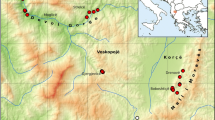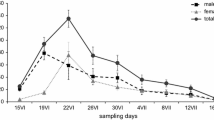Abstract
Relocations of species have become a tool widely used in nature conservation, but insects have rarely been considered as targets. Here, we present a translocation project of the field cricket (Gryllus campestris L. 1758), which is a threatened species at the northern edge of its range. Only ten populations were left in Lower Saxony (Germany), illustrating the need for urgent conservation measures. After 10 years of monitoring and management of an isolated population, 213 nymphs were captured and released at another nature reserve in summer 2001. The size of the new population increased significantly from 27 singing males in spring 2002 to 335 singing males in spring 2005. The occupied area increased from 5.66 ha to 33.14 ha. Altogether, the translocation project was evaluated as successful, but the inland dune proved to be not as suitable for the species as initially expected. Our results indicate that translocations of highly reproductive insect species are promising, as long as the release locality contains sufficiently large areas of suitable habitat and a high number of wild juveniles from a closely located and large source population are released in a climatically favorable period. Management and restoration of habitats, as well as continuous monitoring are of crucial importance for the success of the translocation project. Moreover, the importance of a high quality of cooperation between conservationists, authorities, foresters, farmers, financiers and scientists cannot be overstated.


Similar content being viewed by others
References
Bakker JP, Berendse F (1999) Constraints in the restoration of ecological diversity in grassland and heathland communities. Trends Ecol Evol 14:63–68
Berggren A (2005) Effect of propagule size and landscape structure on morphological differentiation and asymmetry in experimentally introduced Roesel’s bush-crickets. Conserv Biol 19:1095–1102
Ciais Ph, Reichstein M, Viovy N, Granier A, Ogée J, Allard V, Aubinet M, Buchmann N, Bernhofer Chr, Carrara A, Chevallier F, De Noblet N, Friend AD, Friedlingstein P, Grünwald T, Heinesch B, Keronen P, Knohl A, Krinner G, Loustau D, Manca G, Matteucci G, Miglietta F, Ourcival JM, Papale D, Pilegaard K, Rambal S, Seufert G, Soussana JF, Sanz MJ, Schulze ED, Vesala T, Valentini R (2005) Europe-wide reduction in primary productivity caused by the heat and drought in 2003. Nature 437:529–533
Dempster JP, King ML, Laghani KH (1976) The status of the swallowtail butterfly in Britain. Ecol Entomol 1:71–84
Detzel P (1998) Die Heuschrecken Baden-Württembergs. Ulmer, Stuttgart
Duffey E (1977) The re-establishment of the large copper butterfly Lycaena dispar batava obth. on Woodwalton Fen National Nature Reserve, Cambridgeshire, England, 1969–73. Biol Conserv 12:143–158
Dunn RR (2005) Modern insect extinctions, the neglected majority. Conserv Biol 19:1030–1036
Ebenhard T (1995) Conservation breeding as a tool for saving animal species from extinction. Trends Ecol Evol 10:438–443
Fischer J, Lindenmayer DB (2000) An assessment of the published results of animal relocations. Biol Conserv 96:1–11
Grein G (2000) Zur Verbreitung der Heuschrecken (Saltatoria) in Niedersachsen und Bremen. Informationsdienst Naturschutz Niedersachsen 20:74–112
Grein G (2005) Rote Liste der in Niedersachsen und Bremen gefährdeten Heuschrecken mit Gesamtartenverzeichnis. 3. Fassung. Informationsdienst Naturschutz Niedersachsen 25:1–20
Griffith B, Scott JM, Carpenter JW, Reed C (1989) Translocation as a species conservation tool: status and strategy. Science 245:477–480
Griffiths HI, Davison A, Birks J (1996) Species reintroductions. Conserv Biol 10:923–930
Hochkirch A (1996) Die Feldgrille (Gryllus campestris L., 1758) als Zielart für die Entwicklung eines Sandheidereliktes in Nordwestdeutschland. Articulata 11:11–27
Hoelzel AR, Halley J, O’Brien SJ, Campagna C, Arnbom T, Le Boeuf B, Ralls K, Dover GA (1993) Elephant seal genetic variation and the use of simulation models to investigate historical population bottlenecks. J Hered 84:443–449
Holloway GJ, Griffiths GH, Richardson P (2003) Conservation strategy maps: a tool to facilitate biodiversity action planning illustrated using the heath fritillary butterfly. J Appl Ecol 40:413–421
Ingrisch S, Köhler G (1997) Rote Liste der Geradflügler (Orthoptera s. l.). In: Binot M, Bless R, Boye P, Gruttke H, Pretscher P (eds) Rote Liste gefährdeter Tiere Deutschlands, pp 252–254. Schriftenreihe für Landschaftspflege und Naturschutz 55, Bundesamt für Naturschutz, Bonn, pp. 252–254
IUCN (1998) IUCN Guidelines for Re-introductions. IUCN, Gland & Cambridge
Kleukers R, Nieukerken Ev, Odé B, Willemse L, Wingerden Wv (1997) De Sprinkhanen en Krekels van Nederland (Orthoptera). Nederlandse Fauna I, KNNV Uitgeverij & EIS-Nederland, Leiden
Köhler G, Reinhardt K (1992) Beitrag zur Kenntnis der Feldgrille (Gryllus campestris L.) in Thüringen. Articulata 7:63–76
Lande R (1988) Genetics and demography in biological conservation. Science 241:1455–1460
Leberg PL (1993) Strategies for population reintroduction: effects of genetic variability on population growth and size. Conserv Biol 7:194–199
Marshall JA, Haes ECM (1990) Grasshoppers and allied insects of Great Britain and Ireland. Harley books, Colchester, Essex
Pearce-Kelly P, Jones R, Clarke D, Walker C, Atkin P, Cunningham AA (1998) The captive rearing of threatened Orthoptera: a comparison of the conservation potential and practical considerations of two species’ breeding programmes at the Zoological Society of London. J Insect Conserv 2:201–210
Primack R (2002) Essentials of Conservation Biology. 3rd edn. Sinauer Associates, Sunderland, MA
Pyle R, Bentzien M, Opler P (1981) Insect conservation. Ann Rev Entomol 26:233–258
Rawson GW (1961) The recent rediscovery of Eumaeus atala (Lycaenidae) in southern Florida. J Lepid Soc 15:237–266
Regen J (1906) Untersuchungen über den Winterschlaf der Nymphen von Gryllus campestris L. Ein Beitrag zur Physiologie der Atmung und Pigmentbildung bei den Insekten. Zoologischer Anzeiger 30:131–135
Remmert H (1992) Die Populationsdynamik von Feldgrillen und ihre Ursachen. In: Remmert H (eds) Ökologie: Ein Lehrbuch. Springer, Berlin, pp 196–200
Robert A, Sarrazin F, Couvet D, Legendre S (2003) Releasing adults versus young in reintroductions: interactions between demography and genetics. Conserv Biol 18:1078–1087
Sarrazin F, Barbault R (1996) Reintroduction: challenges and lessons for basic ecology. Trends Ecol Evol 11:474–478
Sarrazin F, Legendre S (2000) Demographic approach to releasing adults versus young in reintroductions. Conserv Biol 14:488–500
Singer FJ, Papouchis CM, Symonds KK (2000) Translocations as a tool for restoring populations of bighorn sheep. Restor Ecol 8:6–13
Schmidt K (1998) Zum Vorkommen und zur Bestandssituation der Feldgrille (Gryllus campestris) in SW-Thüringen unter besonderer Berücksichtigung des Wartburgkreises. Veröffentlichungen des Naturhistorischen Museums Schleusingen 13:79–87
Sherley GH (1998) Translocationg a threatened New Zealand giant orthopteran, Deinacrida sp. (Stenopelmatidae): some lessons. J Insect Conserv 2:195–199
Stockwell CA, Mulvey M, Vinyard GL (1996) Translocations and the preservation of allelic Diversity. Conserv Biol 10:1133–1141
Teerling A, Hochkirch A (2002) 10 Jahre Schutz der Feldgrille in der Diepholzer Moorniederung––Ziele, Erfolge und Perspektiven. Verhandlungen der Gesellschaft für Ökologie 32:407
Thorens P, and Nadig A (1997) Atlas de Distribution des Orthopteres de Suisse. Doc. Faun. Helv. 16, CSCF, Neuchâtel
Väisänen R, Kuussaari M, Nieminen M, Somerma P (1994) Conservation biology of Pseudophilotes baton in Finland (Lepidoptera, Lycaenidae). Annales Zoologici Fennici 31:145–156
Webb ND (1998) The traditional management of European heathlands. J Appl Ecol 35:987–990
Whitman DW (1987) Thermoregulation and daily activity patterns in a black desert grasshopper Taeniopoda eques. Anim Behav 35:1814–1826
Witkowski Z, Adamski P, Kosior A, Płonka P (1997) Extinction and reintroduction of Parnassius apollo in the Pieniny National Park (Polish Carpathians). Biologia 52:199–208
Wolf CM, Griffith B. Reed C, Temple SA (1996) Avian and mammalian translocations: update and reanalysis of 1987 survey data. Conserv Biol 10:1142–1154
Acknowledgements
We are grateful to Till Eggers for statistical advice. We would also like to thank Anselm Kratochwil for his constant support and encouragement throughout this project. The Division of Ecology at the University of Osnabrück provided research facilities. Till Eggers, Julia Gröning, Elisabeth Witzenberger and Anselm Kratochwil provided valuable comments on a previous version of the manuscript. The local and regional administrations (Land of Lower Saxony, district government Hannover, NLÖ, NLWKN, Landkreis Diepholz) enabled us to carry out the translocation and all associated surveys. Additionally our thanks go to the Forstamt Binnen and the Sheep farm Grimberg, who supported and carried out habitat management measures. We owe great thanks to our financial supporters (Land of Lower Saxony, Bingo Lotto, Deutsche Umwelthilfe, Stiftung Naturschutz im Landkreis Diepholz, Arbeitsamt Nienburg, BUND, University of Osnabrück).
Author information
Authors and Affiliations
Corresponding author
Rights and permissions
About this article
Cite this article
Hochkirch, A., Witzenberger, K.A., Teerling, A. et al. Translocation of an endangered insect species, the field cricket (Gryllus campestris Linnaeus, 1758) in northern Germany. Biodivers Conserv 16, 3597–3607 (2007). https://doi.org/10.1007/s10531-006-9123-9
Received:
Accepted:
Published:
Issue Date:
DOI: https://doi.org/10.1007/s10531-006-9123-9




